LED technology has revolutionised the lighting industry, offering unprecedented energy efficiency, durability and adaptability. The direction of light from luminaires has a significant impact on the lighting of a space, and directionality adds to the versatility of a luminaire.
This article discusses the principles of directional LED lighting, its numerous benefits and practical applications in different sectors. Tailoring LED lighting systems to user needs and optimisation tips to maximise performance will also be discussed.
Direction of light – a technical issue
The direction of light is the bending of light as it passes from one transparent substance to another. This is due to the change in the speed of light in different substances. This theory is used in the manufacture of lenses.
The direction of light allows the existence of lenses, magnifying glasses, prisms and rainbows. Even the function of our eyes depends on the bending of light.
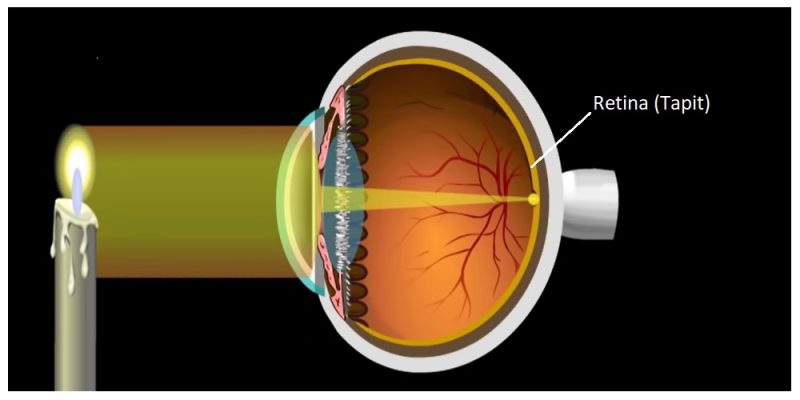
Materials and angle of incidence of light
The direction of the light depends on three things: the change in the speed of the light, the angle of the input beam, and the material the light hits. If a substance slows down or speeds up light more, it bends more. If light enters the substance directly (at a 90° angle to the surface), it slows down but does not change direction at all. This is why, for example, textured tiles or crystal reflect light in many directions and therefore the choice of materials has a big impact on the direction and reflection of light. Remember that the black colour reflects light less well than the white colour.
Refractive index of some transparent substances
| Substance | Refractive index | Speed of light in the material (x 1,000,000 m/s) |
Angle of refraction, if the incoming beam comes in to the substance at 20ºC |
| Without |
1.00 |
300 |
20 |
| Water |
1.33 |
226 |
14.9 |
| Glass |
1.5 |
200 |
13.2 |
The refractive index of a substance shows how much light slows down and changes direction in it. The higher the refractive index, the more the light bends. This is therefore an issue to consider when making the lenses and the choice of material. There are differences in the lens whether they are made of plastic or glass.
The lens controls the light
A lens is simply a curved piece of glass or plastic. There are two types: a double-concave lens, which is thicker in the centre than at the edges, and a double-concave lens, which is thinner in the centre than at the edges. They affect light in different ways.
A double-concave lens reduces the light rays to a single point at a certain angle, which depends on the convexity of the lens.
A double cone, on the other hand, spreads the light rays, depending on the concavity of the lens.
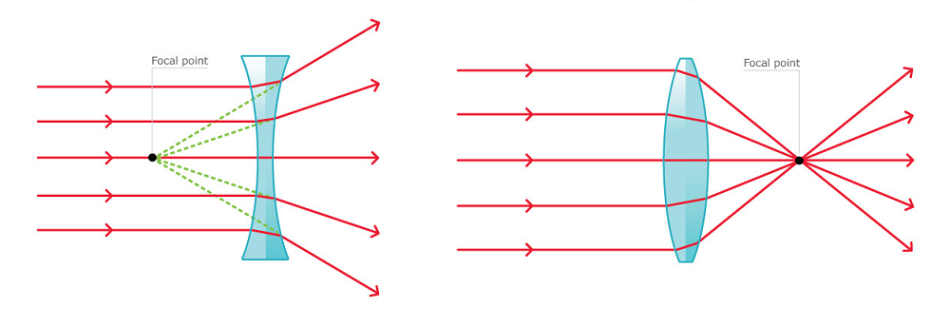
For the source and more on light refraction, see the article below.
LED lighting directional principles
The basic concepts of light sources relate to the control and management of lighting based on the direction of light from LEDs. Direction and light control are important factors in maximising lighting efficiency and functionality. Unlike traditional incandescent lamps or fluorescent tubes, which emit light in all directions, LED lights have an inherent orientation due to their semiconductor structure. This unique feature enables precise light direction control, minimising energy waste from unnecessary lighting.
Different strategies can be used to optimise the directional accuracy and beam control of LED lighting. One such approach is the use of optics, which involves manipulating light through lenses or reflectors that direct it to intended targets, reducing the loss of light intensity. Optical elements can be tailored specifically for individual applications, ensuring that defined spaces receive adequate illumination without glare. In addition, the correct fixing method will help to achieve the desired results by ensuring that the luminaires are mounted at the correct angle in relation to the surfaces to be illuminated.
Technological advances have made it possible to control the directional accuracy of LED lighting using increasingly complex methods. For example, with adjustable optics, users gain greater flexibility by making changes after installation – a feature that is particularly useful in environments where frequent adjustments or reconfiguration is required.
In addition, the integrated sensors offer further opportunities to improve directional accuracy by actively monitoring environmental conditions and adjusting the output accordingly.
Benefits of LED lighting orientation
The benefits of LED lighting orientation cover various aspects such as energy efficiency, improved design flexibility and enhanced visual comfort. The use of directional LEDs reduces energy consumption by minimising wasted light and maximising the luminous intensity of the luminaires. In addition, the diversity of design options allows architects and lighting designers to create tailor-made solutions that optimise occupant comfort while respecting aesthetic preferences and functional requirements.
Energy efficiency
Optimising the energy consumption of lighting solutions has become a key factor in creating sustainable and cost-effective environments. Saving energy and adopting sustainable solutions are important to reduce greenhouse gas emissions, lower utility costs and minimise the overall environmental impact. LED lighting technology is widely recognised for its energy efficiency, offering significant advantages over traditional incandescent or fluorescent lighting systems.
The direction of light from LED luminaires affects their energy efficiency in many ways:
- Directional lighting: unlike traditional light sources, which emit light in all directions, LED lights produce precisely directed light. This reduces wasted lighting, which saves energy. for example, a traditional fluorescent tube will illuminate in all directions and a led tube only where light is needed.
- Less heat insulation: LED lights produce less heat compared to other light sources due to their higher efficiency. This leads to reduced cooling requirements in buildings and further savings in energy consumption.
- Longer lifetime: the extended lifetime of LED lights results not only in reduced maintenance and repair costs, but also in lower overall energy consumption over their lifetime.
In conclusion, incorporating the direction of light from LED luminaires into lighting design allows for greater control over lighting levels while optimising energy use. The global emphasis on sustainability continues to grow, and the adoption of such efficient technologies is essential to address both economic constraints and environmental concerns in modern infrastructure projects.
Improved design flexibility
The use of energy-efficient lighting solutions allows for greater design flexibility, enabling architects and designers to create aesthetically pleasing spaces that are sustainable. The direction of light from LED luminaires is an important factor in this design flexibility. Thanks to their compact size and low heat output, LED lights can be integrated into a variety of flexible installations without compromising the structural integrity or thermal performance of the building. This allows innovative arrangements that not only improve the visual appeal of spaces, but also optimise the distribution of light for specific tasks or purposes.
An advantage of using LED lighting technology, mentioned earlier, is its ability to produce directional light that can be easily manipulated and controlled by optics and reflectors. This feature gives designers more options to adapt lighting designs and texture to space requirements and user preferences.
In addition, LED lights can be integrated in various forms such as strips, panels, linear modules or even embedded directly into materials such as concrete or glass. This versatility enables the creation of unique lighting schemes that blend seamlessly with architectural elements while providing efficient lighting levels. Ultimately, these features contribute to both aesthetics and functionality in modern buildings designed for sustainability.
Good visual comfort
Achieving good visual comfort is yet another advantage of implementing energy-efficient lighting solutions in modern architectural designs. The direction of light from LED luminaires, or the direction of light from the LED luminaires themselves, is crucial to achieving this goal. The ability to control and optimise the distribution of light can significantly improve visual comfort by reducing glare, maintaining adequate brightness levels and focusing lighting on the desired object. This is particularly important in spaces where individuals need to perform visually demanding tasks, such as offices, schools, hospitals and other commercial environments.
Optimal lighting placement and consideration of the various visual comfort factors contribute to an overall improvement of the user experience in the space. Some key aspects that contribute to good visual comfort are:
- Uniformity: ensuring even light distribution over the surface minimises shadows and creates a more comfortable environment for users.
- Colour temperature: choosing the right colour temperature based on the activity or atmosphere in the room can help improve visual perception and mood.
- Glare reduction: properly designed luminaires with optimal opening angles help reduce glare and provide adequate lighting for tasks.
- Adaptability: lighting systems with adjustable colour temperature and brightness allow users to customise features based on individual preferences or requirements.
By integrating these elements into lighting design, architects and designers can achieve good visual comfort while benefiting from the energy efficiency and durability offered by LED technology.
Practical applications
The practical applications of LED lighting cover a range of sectors, including residential, commercial and outdoor or landscape lighting. In homes, such lighting offers energy-efficient alternatives to improve the indoor ambience, while in commercial spaces it promotes a more productive working environment and reduces operating costs. In addition, the versatility of LED technology enables a wide range of outdoor installations that enhance aesthetics and promote safety in both urban and natural environments.
Residential lighting
Residential lighting plays an important role in improving the atmosphere and functionality of living spaces, just as a well-placed lighthouse guides ships safely through dangerous waters. The direction of light from LED luminaires is an essential consideration when designing residential lighting. The right direction and distribution of light can dramatically improve the aesthetics of a living environment, while ensuring that spaces are properly lit for different activities.
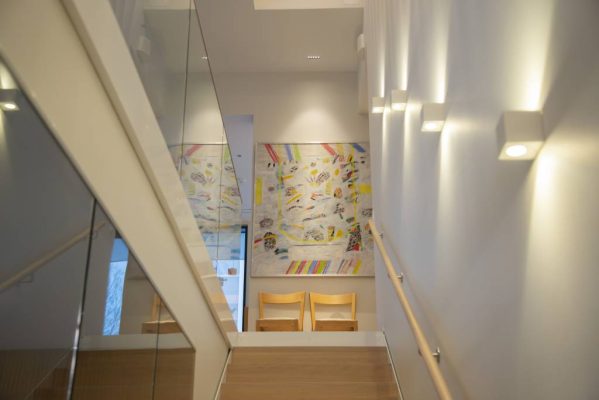
In addition, the integration of smart controls into lighting systems will allow residents to further customise their lighting choices.
- Task lighting: this type of lighting focuses on providing adequate lighting for specific tasks such as reading, cooking or computer use. By directing LED light to work surfaces and using adjustable luminaires, task-specific lighting can improve productivity and reduce eye strain.
- General lighting: this general lighting determines the overall brightness of the room and makes a significant contribution to the aesthetics of the home by creating a comfortable atmosphere. By choosing LED luminaires with diffuse light output and using indirect lighting techniques, uniform general lighting can be achieved while reducing glare.
- Accent lighting: accent lighting is intended to highlight architectural elements, works of art or other decorative elements in living spaces. By carefully positioning LED luminaires with narrow beam angles or using wall luminaires that direct light upwards or downwards, accent lights can highlight the focal points of a dwelling.
By understanding the importance of the direction of light from LED luminaires, households can optimise their lighting design in terms of both aesthetic appeal and practicality. The inclusion of smart controls, such as Zigbee or DALI, offers more customisation options and promotes energy efficiency through operating models tailored to individual needs and preferences.
Commercial lighting
In commercial environments, well-designed lighting systems not only increase productivity and safety, but also create a visually attractive atmosphere that can leave a lasting impression on customers and visitors. Innovative lighting solutions for commercial premises are essential to provide optimal working conditions while promoting energy efficiency, reducing maintenance costs and ensuring compliance with relevant regulations.
The direction of light from LED luminaires plays an important role in achieving the desired lighting effects in commercial environments. The designed direction of light from LED luminaires can be manipulated to achieve different objectives, such as highlighting architectural features, emphasising the presentation of products or creating certain atmospheres. The table below shows three different applications that benefit from strategically placed LED lights:
| The app | Lighting target | LED lighting trend strategy |
|---|---|---|
| Office space | Optimal task lighting and reduced glare | Indirect/direct lighting installed on adjustable task lights |
| Retail outlets | Highlight products and create an attractive atmosphere | Directional spot lights and wall lighting to highlight presentations |
| Restaurants and hotels | Improve the atmosphere and ensure the comfort of your guests | A mix of general, task and accent lighting to suit the design of the space |
By carefully considering the purpose and function of each area in a commercial space, designers can select the appropriate LED luminaires that provide an adequate level of light while blending seamlessly with the aesthetic appeal of the environment. In addition, advances in technology have enabled greater control over colour temperature and power, allowing companies to fine-tune their lighting designs to meet specific needs or preferences.
Outdoor and landscape lighting
Outdoor and landscape lighting solutions are an important part of improving the aesthetics of the outdoor space, promoting safety and creating an inviting atmosphere. These lights are designed to enhance architectural features, illuminate walking and pathways, highlight landscape elements and provide functional lighting for outdoor activities.
Properly designed and implemented outdoor lighting systems not only “‘””‘add to the overall visual appeal of a property, but also ensure that spaces remain safe and accessible after dark. Landscape lighting is an important part of this approach, as it focuses on showcasing the natural beauty of gardens, trees, rock and other outdoor elements.
There are several factors to consider when designing efficient outdoor lighting systems:
Firstly, the choice of luminaires should be based on their intended use – whether they are for general area lighting or to highlight specific features in a targeted way. In addition to choosing the right types of luminaires, such as spotlights or floodlights, attention must also be paid to factors such as colour temperature and opening angle, which can greatly affect the final result.
Secondly, the correct positioning of these luminaires is crucial to achieve a harmonious balance between shadows and highlights, avoiding the over-exposure or glare problems that can easily occur with an overly powerful luminaire when it hits the surface to be illuminated.
Last but not least, the incorporation of energy-efficient LED technology together with smart control options can further enhance both the aesthetic appeal and sustainability aspects of any outdoor lighting design project. Use twilight detectors outdoors
Orientation of adjustable LED lighting
Aligning LED lighting in a customizable way involves several key elements, such as selecting the appropriate LED luminaire, adjusting the beam angle and adjusting the light intensity. Careful consideration of these factors can optimise energy efficiency and create a tailored lighting environment that meets specific requirements. A thorough understanding of these elements enables informed decision-making when designing tailored lighting solutions to suit different applications and preferences.
Choose the right LED luminaires.
Choosing the right luminaire is important for optimising the lighting direction and improving the overall ambience. The choice of luminaire should be based on factors such as compatibility with LED technology, the desired lighting effect and the specific needs of the area. In addition, installation techniques have a significant impact on the efficiency of LED luminaires in directing light where it is most needed. Proper installation can ensure that LED lights perform optimally and maintain their durability while providing efficient and customized lighting solutions.
When choosing a luminaire, it is important to take into account a variety of “‘””‘things such as the angle of opening, colour temperature, lumen output and luminaire design.
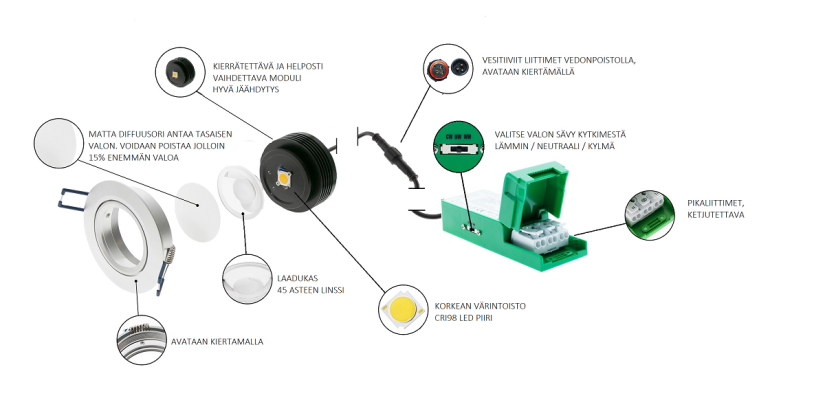
The angle at which the light is reflected determines how wide or narrow the light is spread; wider angles provide more general illumination, while narrower angles focus on specific areas or objects.
The colour temperature determines whether the emitted light looks warm (yellow) or cool (blue), which can have a significant impact on the mood of the room.
Lumen output refers to the brightness level produced by the LED luminaire; higher lumens indicate brighter lights suitable for larger spaces or task-oriented applications.
Finally, the luminaire design must meet both functional requirements and aesthetic preferences, creating cohesive interior designs that effectively incorporate LED technology in modern settings. By carefully considering these factors during luminaire selection and following proper installation techniques, individuals can optimize the direction of light from LED luminaires for virtually any environment.
Adjust the beam angle and power
The previous discussion focused on the selection of suitable LED luminaires to meet specific lighting needs. After choosing an LED luminaire, it is important to ensure that these lights also provide optimal illumination and coverage for their intended applications. This can be achieved by adjusting the orientation and power of the LED lights, which affects the final lighting quality.
Light manipulation and directional control are important aspects of adjusting the direction of light from LED luminaires. By changing the angle of the light rays, users can control how wide or narrow the light is spread; wider angles produce softer light with wider coverage, while narrower angles produce more intense rays of brighter light over a smaller area.
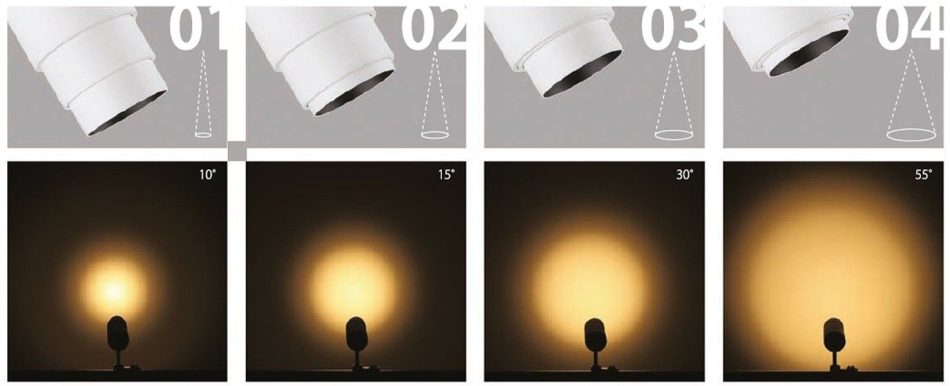
Dimming controls can also be used to adjust the intensity of the light. These adjustments help to create a balanced lighting system that serves both aesthetic preferences and functional requirements in different environments such as residential, commercial and industrial spaces.
Tips for optimising the directionality of LED lighting.
Optimising the direction of light from energy-efficient light sources can significantly improve the overall visual experience and functionality in different environments. Careful consideration of the placement of LED luminaires allows for optimal light distribution while minimizing glare and other negative effects on occupant comfort and performance. Achieving this balance requires a thorough understanding of a number of factors, including:
Room dimensions and shape
- The size and shape of the space will determine the number of luminaires needed and their placement.
- The right distance between lights ensures even coverage throughout the room.
- Attention should be paid to any obstacles or surface materials that may affect the reflection or absorption of light.
User needs and functions
- Different tasks require different light brightness levels and contrasts; therefore, directional control needs to be adapted to these needs.
- For example, workstations may need direct task lighting, while relaxation areas could benefit from softer ambient lighting.
Luminaire design features
- Adjustable orientation options allow precise targeting of specific objects or areas in space.
- Choosing the angle of the beam (i.e. choosing the right luminaire) helps to tailor light distribution patterns to specific needs. e.g. narrow beams for accent lighting or wide beams for wide coverage.
Optimal positioning plays an important role in reducing glare by ensuring that LED luminaires are positioned so that they do not shine directly into the eyes of users. Glare reduction can be achieved by strategic lighting arrangements, using properly installed luminaires or diffusers to soften the light, or using indirect lighting where necessary. This approach not only maintains user comfort but also prevents potential interference from excessive brightness levels.
To achieve the optimal LED lighting orientation, it is important to consider all of the above factors during the design stages. A thoughtful combination of appropriate luminaire design features, room layout considerations and user-specific requirements results in functional spaces with enhanced visual appeal. In addition, minimising glare further contributes to occupant satisfaction by providing comfortable working environments free from unnecessary distractions.
Frequently asked questions
How do the direction and colour rendering of the light from an LED luminaire affect the overall lighting and mood of a room?
An astonishing 80% of people report being more productive in a well-lit environment (Lighting Research Center, 2014). The colour temperature of an LED light source has a significant impact on its effect on the overall lighting experience and mood in a room. Colour perception is affected by a variety of factors, such as the hue and intensity of the light from the LED source. Warmer colour temperatures (2700K-3000K) tend to create calming, inviting atmospheres, while cooler colour temperatures (4000K-6500K) create vibrant, energising environments. The delicate balance between these two extremes can have a significant impact on a person’s mood and behaviour. It is therefore important to carefully consider the desired ambience when choosing the right LED lights for any space, to ensure optimum productivity and comfort levels.
How do LED luminaires compare in terms of energy efficiency and life cycle to traditional incandescent or energy-saving light bulb options?
When comparing the energy efficiency and lifetime of different lighting options, it is clear that LED technology outperforms traditional incandescent and compact fluorescent lamp (CFL) options. Significant energy savings can be achieved by using LED lights, which consume about 75% less energy than incandescent lamps and about 50% less than CFLs. In addition, the lifetime comparison reveals a significant advantage for LED lights, which have an average life expectancy of 25,000-50,000 hours – significantly longer than the 1,000 hours for incandescent bulbs and 8,000-10,000 hours for CFLs.
What is the environmental impact of LED luminaires, including manufacturing, disposal and recycling?
A recent study on the environmental impact of LED lighting found that while LED technology has demonstrated significant energy efficiency and lifetime benefits compared to traditional incandescent or CFL lighting options, there are still concerns about the pollution generated in the manufacturing process. LED production requires many hazardous materials, which are involved in the pollution of LED manufacturing. However, many plants have implemented giant minimisation measures to reduce these environmental impacts. As demand for energy-saving lighting solutions continues to grow, it is important that industry stakeholders and decision-makers prioritise minimising the environmental footprint of LED lights throughout their life cycle – from production to disposal and recycling. LedStore luminaires use 95% recycled aluminium in their manufacture.
Are there any potential health risks from long-term LED light directionality, such as eye strain or disruption of circadian rhythms?
Research on the health effects of LED lights has shown that long-term exposure to certain LED lights can lead to potential adverse effects such as eye strain and circadian rhythm disturbances. The high-energy blue light (HEV) in some LED lights can cause digital eye strain, resulting in discomfort after prolonged display time. In addition, exposure to blue light in the evening has been linked to suppression of melatonin secretion, which plays an important role in regulating sleep and wakefulness. This disruption to the body’s natural sleep cycles could potentially lead to sleep disturbances and affect overall well-being. While LED lighting offers numerous benefits in terms of energy efficiency and sustainability, it is important that manufacturers and consumers take these health impacts into account when designing and using products incorporating LED technology.
Conclusion
In conclusion, controlling the direction of lighting from luminaires offers significant benefits in a variety of applications. Proper deployment and adaptation of these lighting devices will allow for optimal efficiency, lower costs and improved aesthetics. The use of this innovative technology can revolutionise modern spaces by providing a visually pleasing atmosphere.
In a satirical description, one can imagine a world where poorly directed LED lighting causes chaos and inefficiency. On the other hand, the ideal situation highlights an environment where carefully designed lighting techniques result in harmonious environments that serve both form and function. It is clear that understanding and optimising the direction of LED lighting is crucial to maximising its potential benefits.
Lighting expert
LedStore has been an expert in LED lighting and lighting design since 2010. We have our own product design, so our products are technologically state-of-the-art. Products have quarantee for up to 7 years. We also carry out lighting maintenance.
We focus on temperature-controlled and high colour rendering lights, so they work brilliantly and last a long time. We do around 500 lighting designs for our clients’ sites. Read more here or order a lighting design
We offer a service of custom-made led strips, i.e. custom-made led strips in aluminium profile. Also installed. Did you know? LedStore offers lighting design from 99 euros for the whole house!
Remember that we are always ready to offer our help to you along the way, by email (myynti@ledstore.fi) and by phone (045 251 4510). As always, feel free to share photos of your own projects on social media at ledstore.fi at Instagram and ledstore.fi at Meta. We love to see the great things our LEDs do, and it helps to provide inspiration for those who are unsure of the power and awesomeness of LEDs. Did you know that we already have over 3500 pictures of our LED installations in our Gallery!
Gallery of Led lights:
Product gallery: Pictures of products in different installation locations
Indirect light: Indirect light in different spaces
Room-specific: Light in different rooms
References: Complete houses that have been photographed

